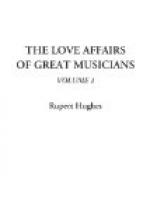“most Sincerely, Faithfully
“and most affectionately yours
“Sunday Evening, June 10, 1792”
“M.D.
“I was extremely sorry I had not the pleasure of seeing you to-day, indeed my Dst Love it was a very great disappointment to me as every moment of your company is more and more precious to me now your departure is so near. I hope to hear you are quite well and I shall be very happy to see you my Dst Hn. any time to-morrow after one o’clock, if you can come; but if not I shall hope for the pleasure of Seeing you on Monday. You will receive this letter to-morrow morning. I would not send it to-day for fear you should not be at home and I wish to have your answer. God bless you my Dst. Love, once more I repeat let me See you as Soon as possible. I ever am with the most inviolable attachment my Dst and most beloved H.
“most faithfully and most
“affectionately yours
“R.S.”
“I am just returned from the concert where I was very much Charmed with your delightful and enchanting Compositions and your Spirited and interesting performance of them, accept ten thousand thanks for the great pleasure I always receive from your incomparable Music. My D: I intreat you to inform me how you do and if you get any Sleep to Night. I am extremely anxious about your health. I hope to hear a good account of it. god Bless you my H: come to me to-morrow. I shall be happy to See you both morning and Evening. I always am with the tenderest Regard my D: your Faithful and Affectionate
“Friday Night, 12 o’clock.”
This is the last of these letters to which one could apply so fitly the barbarous word “yearnful,” once coined by Keats. After Haydn’s return to London, in 1794, there are no letters to indicate a continuance of the acquaintance, but it doubtless was renewed, judging from the sagacious guess based upon the fact that Haydn did not come back to his old lodgings but took new ones at No. 1 Bury Street, St. James’s.
This much more pleasantly situated dwelling, he probably owed to the considerate care of Mrs. Schroeter, who, by the same token, thus brought him nearer to herself. A short and pleasant walk of scarcely ten minutes through St. James’s Palace and the Mall (a broad alley alongside of St. James’s Park) led him to Buckingham Palace, and near at hand was the house of Mrs. Schroeter. Perhaps he preferred the walk to letter-writing. When he went away from London for ever, he left behind him the scores of his six last symphonies “in the hands of a lady,” probably Mrs. Schroeter. It was this same woman to whom Haydn dedicated three trios, his first, second, and sixth. It was undoubtedly she to whom he referred when he made that little speech which Dies probably misquoted, in telling the answer Haydn gave him when he was asked what the letters were. “They are letters from an English widow in London who loved me; she was, though she already counted her sixty years, still a pretty and lovely woman, whom I would very probably have married had I then been single.”




